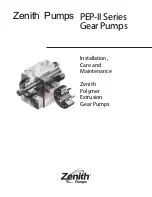
Operation Manual
6.3 Cleaning In Place (CIP)
The pump can be manually cleaned or
cleaned in place(CIP). The following is an
example of a typical CIP procedure. Specific
requirements for each application should be
dictated by the carrier/shipper.
Determine last product handled by the
pump
Remove the dust caps and/or fittings
from the pump, rinse any residue from
them with hot water.
Connect hot water hose to the pump
inlet or connect pump inlet to the tank
trailer outlet valve during the tank
’s
hot water cleaning cycle.
When not fitted connect a ball or gate
valve (to restrict liquid flow) to the
pump discharge outlet.
If driven hydraulically, ensure that the
hydraulic proportional control valve is
in the neutral position.
If driven hydraulically or electric/
hydraulically, start system and run at
normal operating speed. Open the
ball or gate valve on the pump
cleaning system so the hot water or
cleaning solution from the tank flows
into the pump. (hot water should be
176°F to 194°F) If hydraulically driven,
select forward on the proportional
control valve and slowly increase (by
pushing the handle) to full pump speed.
When driven electrically start the
system and slowly increase the speed
with the handwheel on the belt variator.
Using the ball or gate valve, (to
restrict liquid flow) increase the pump
pressure to approximately 60-75 psi
while it is operating. A pressure gauge
at the discharge outlet will be required.
This will ensure that the cleaning
solution is cleaning the pump under
high pressure conditions.
Run the pump for 15 minutes under this
pressure.
Relief Valve Pumps Only
WARNING: Do not complete this next
step if your pump does not have a
relief valve !!
Close the ball or gate valve (to restrict
liquid flow) until the pump relief valve
actuates. Open the valve and close it
again. Open valve once again - this
should have now cleaned any residue
from behind the relief valve diaphragm
and any other close tolerance areas
inside the pump.
Shut down pump system in reverse
order of above.
Clean all external fittings from the
fittings box with hot water and return.
Remove all hose and fittings from the
pump, bag ends and seal the ports.
IMPORTANT
Do not subject the pump to rapid temperature
changes as pump seizure can result from thermal
shock.
STP125 Page 15
















































